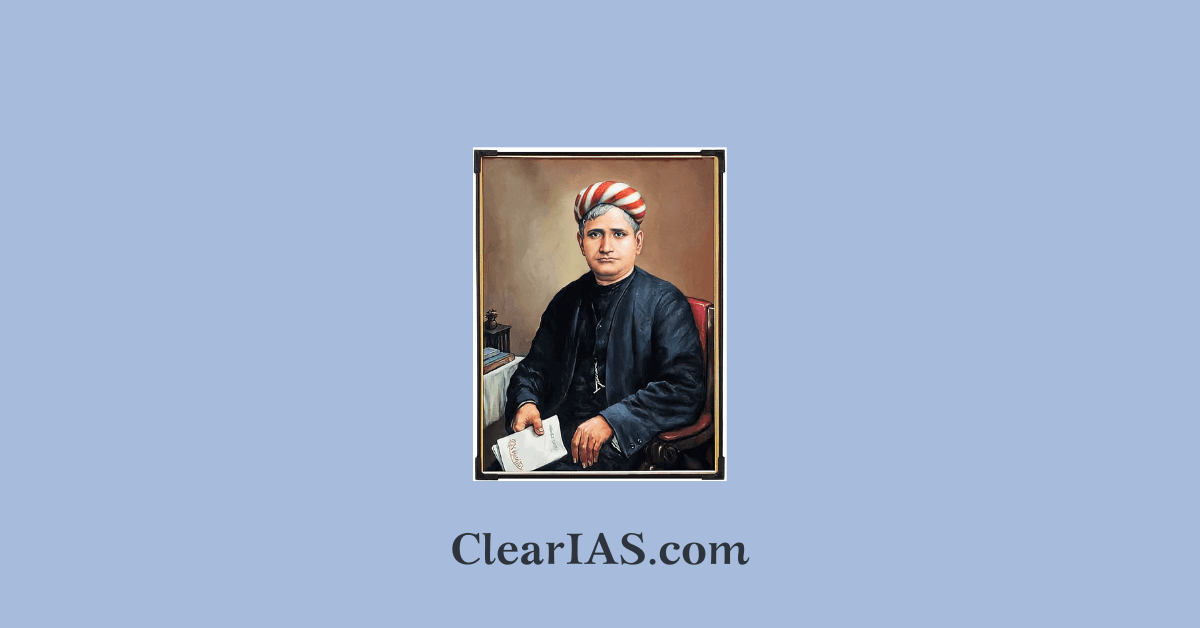
The 185th birth anniversary of Bankim Chandra Chattopadhyay was celebrated on 27th June 2024. Read here to learn more about his life.
Bankim Chandra Chattopadhyay’s political philosophy stemmed from the firm belief that Indian society must synergize the best practices of the West without acknowledging a total subservient self-surrender to Western culture. He was thoroughly interested in European literature, Enlightenment thought, and Western polemic on rationality and morality.
His worldview was shaped by Comtean Positivism, Bentham’s Utilitarianism, John Stuart Mill’s audacious take on social and gender philosophy, and also by strands of French Socialism. He was a champion of modernity and progressive cosmopolitanism, yet he certainly promoted the need to reclaim one’s Indian roots.
Bankim Chandra Chattopadhyay
Bankim Chandra Chattopadhyay (also spelt Chatterjee) was a prominent Indian novelist, poet, and journalist, widely regarded as one of the key figures in the literary renaissance of Bengal in the 19th century.
Early Life and Education
Bankim Chandra Chattopadhyay was born on June 27, 1838, in the village of Kanthalpara in the 24 Parganas district of Bengal (now in West Bengal, India).
- He was born into a Brahmin family. His father, Yadav Chandra Chattopadhyay, was a government official.
- Primary Education: Bankim Chandra received his early education at Hooghly Mohsin College.
- Higher Education: He graduated from the Presidency College, Calcutta (now Kolkata) in 1858, becoming one of the first graduates of the University of Calcutta. He later earned a law degree.
- Bankim Chandra joined the British Indian government as a deputy magistrate and deputy collector. He served in various capacities for over three decades.
Literary Contributions
- Novels: He is best known for his novels which include classics like “Durgeshnandini” (1865), “Kapalkundala” (1866), “Mrinalini” (1869), and “Anandamath” (1882).
- Poetry: Bankim Chandra wrote several poems, but he is most famous for his composition “Vande Mataram,” which became a national song and inspired many during the Indian independence movement.
- Essays and Journals: He was an editor and contributor to several journals and magazines, promoting Bengali literature and culture.
- Historical Works: His novel “Rajmohan’s Wife” is considered the first Indian novel in English. His historical novels, often set against the backdrop of significant events, evoked a sense of patriotism among readers.
Most Notable Works
- Durgeshnandini (1865): His first Bengali romance and one of the earliest Indian novels.
- Kapalkundala (1866): Another popular romantic novel.
- Anandamath (1882): This novel is famous for introducing the song “Vande Mataram,” which became the national song of India. The novel depicts the Sannyasi Rebellion against the British in Bengal.
- Devi Chaudhurani (1884): A story of a female protagonist who turns into a rebel leader.
- Krishnakanter Will (1878): A social novel with a critical perspective on contemporary society.
Anandmath
Anandamath is a seminal work of Indian literature, written by Bankim Chandra Chattopadhyay and first published in 1882.
This novel holds a significant place in Indian history and culture for its nationalist themes and its role in inspiring the Indian independence movement.
- The novel is set during the late 18th century, specifically around the time of the Bengal famine of 1770 and the early British colonial period. It follows the story of a group of ascetic warriors, the Sannyasis, who are fighting against the oppressive British rule and the decadent Muslim rulers of Bengal.
- One of the most enduring legacies of Anandamath is the song “Vande Mataram” (Hail to the Mother), which became a patriotic anthem for the Indian independence movement. The song was later adopted as the national song of India and continues to hold deep emotional and cultural significance.
Legacy
- Vande Mataram: The song “Vande Mataram” from his novel “Anandamath” was adopted as the national song of India. It played a crucial role in the Indian independence movement, inspiring freedom fighters.
- Cultural Impact: Bankim Chandra is often regarded as the “Sahitya Samrat” (Emperor of Literature) in Bengali literature. His novels and essays shaped the cultural and intellectual landscape of Bengal and India.
- Influence on Indian Nationalism: His works, particularly “Anandamath,” instilled a sense of nationalism and pride in India’s heritage among readers.
Death
Bankim Chandra Chattopadhyay passed away on April 8, 1894, in Calcutta (now Kolkata), West Bengal, India.
Conclusion
Bankim Chandra Chattopadhyay’s contributions to Bengali literature and the Indian independence movement are immense.
His novels, essays, and the immortal song “Vande Mataram” continue to inspire generations.
Anandamath by Bankim Chandra Chattopadhyay is more than just a literary work; it is a historical document that captures the spirit of resistance and the yearning for independence among Indians during British colonial rule. Its themes of nationalism, sacrifice, and the divine motherland continue to inspire and evoke patriotic feelings among Indians.
He remains a towering figure in Indian literature and a key personality in the cultural history of India. His works not only enriched Bengali literature but also played a significant role in the awakening of national consciousness among Indians.
Relates articles:
- Indian independence movement
- Modern Indian history books and authors
- Salient aspects of art forms, literature, and architecture from ancient to modern times
-Article by Swathi Satish






Leave a Reply